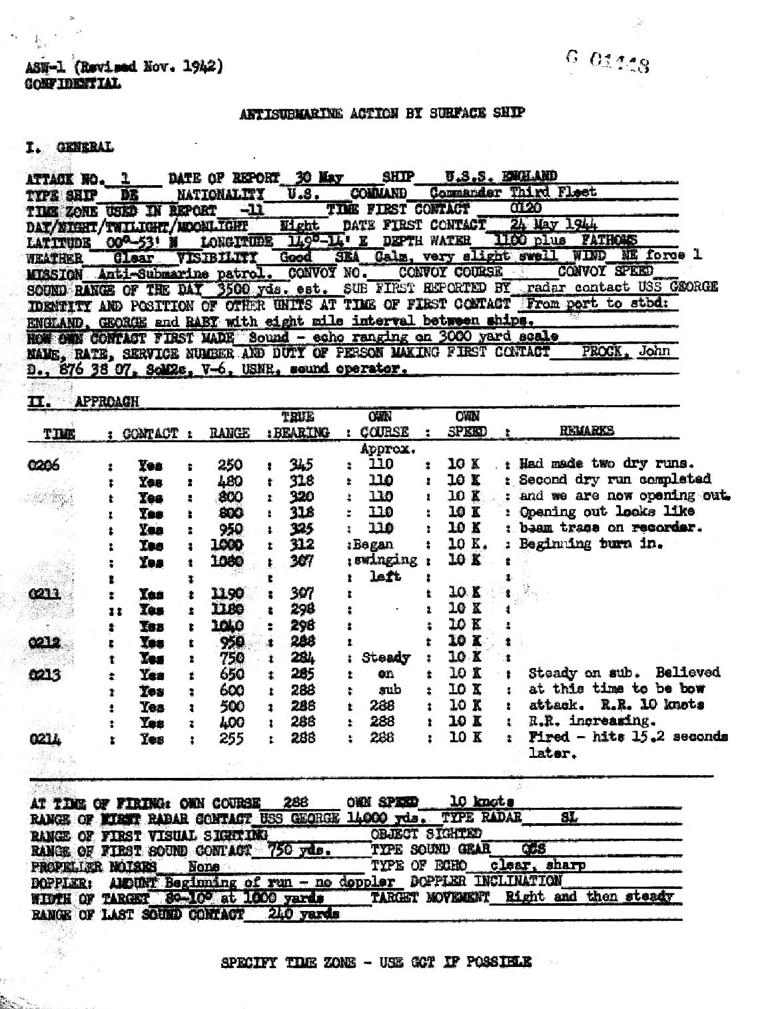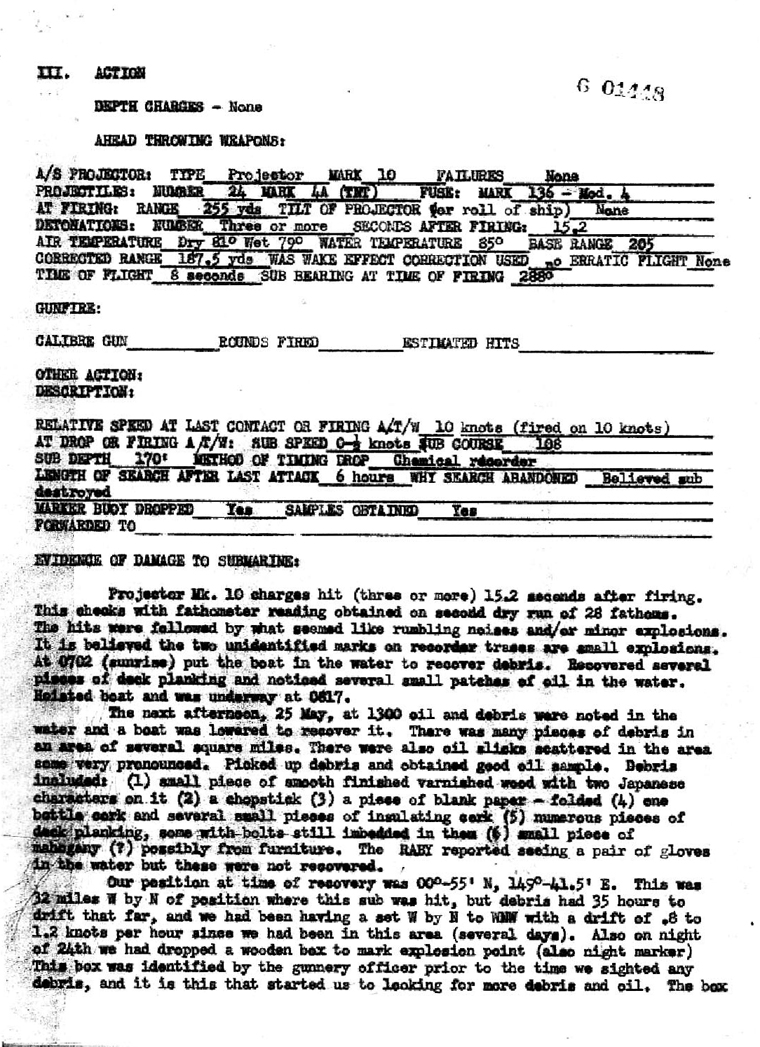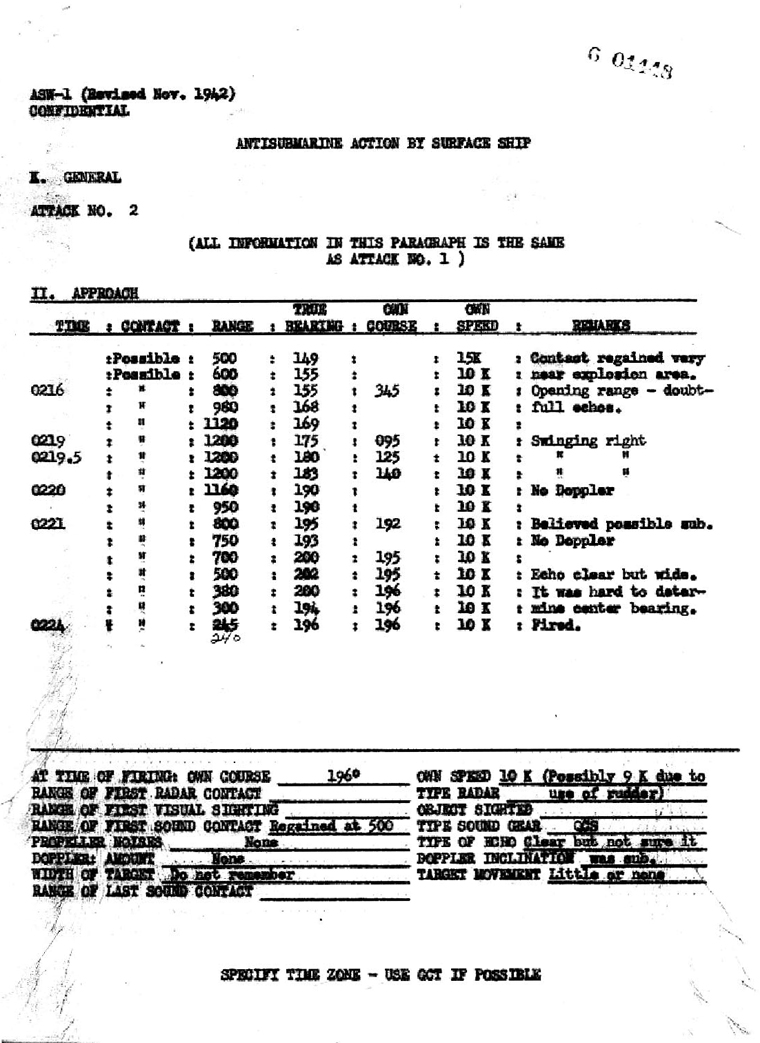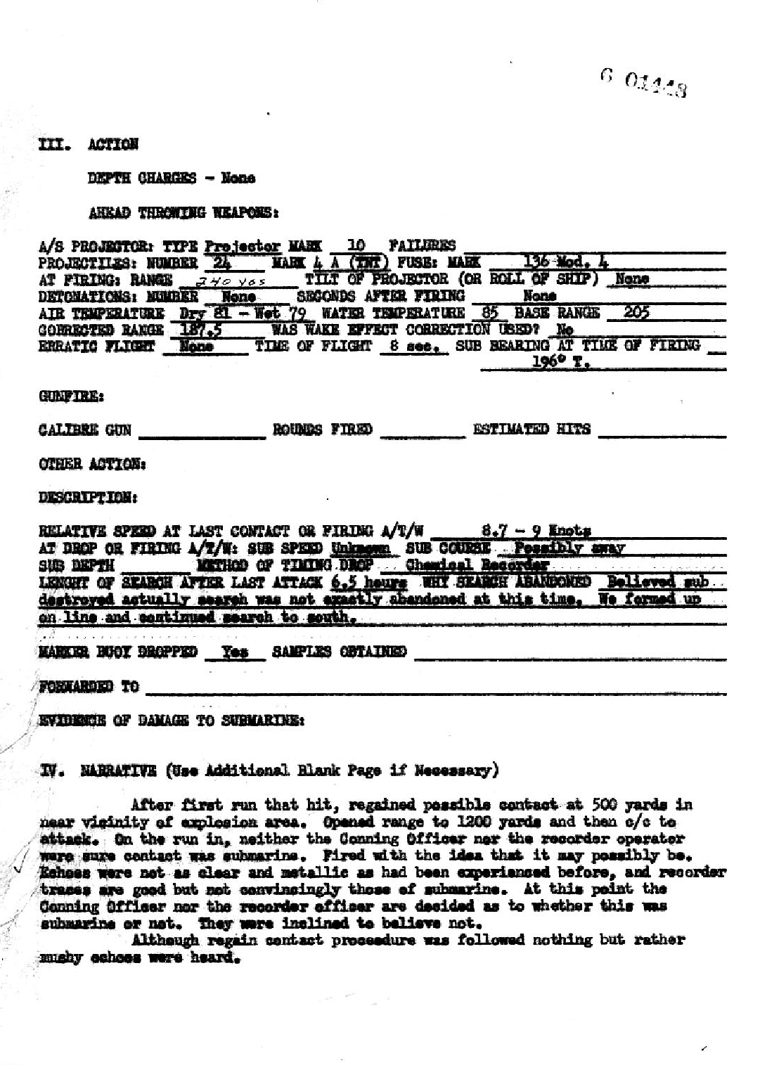| DE635/A16-3 U. S. S. ENGLAND (DE 635) | ||||||||||||||||||||||||||
| Serial No. 018 | ||||||||||||||||||||||||||
| c/o Fleet Post Office, | ||||||||||||||||||||||||||
| San Francisco, Calif., | ||||||||||||||||||||||||||
| CONFIDENTIAL 24 May 1944. | ||||||||||||||||||||||||||
|
||||||||||||||||||||||||||
| 1. The following report is submitted in accordance with reference (a). | ||||||||||||||||||||||||||
| 2. On 24 May, 1944, the U.S.S. ENGLAND, with ComCortDiv 40 aboard, U.S.S. RABY and U.S.S. GEORGE, with ComCortDiv 39 aboard as OTC, were conducting anti-submarine steaming patrol on base course 216° true, in formation scouting line normal to base course, interval eight miles, when at 0120 Love, the GEORGE made radar contact on what was presumed to be a surfaced submarine almost dead ahead of them at range of 14,000 yards. ENGLAND was to port of the GEORGE and the RABY to starboard. On contact both ships changed course to head for submarine and went to 20 knots. | ||||||||||||||||||||||||||
| At 0128, while the GEORGE was still 9,000 yards distant the target disappeared from the screen. At 0147 ENGLAND slowed to 15 knots and began sound search on advice of CIC. Made good sound contact at 0150, bearing 307° true, range about 750 yards, and proceeded to attack. | ||||||||||||||||||||||||||
| 3. This submarine was by far the trickiest we had encountered. We were forced to make two dry runs before our firing run, on which we hit. | ||||||||||||||||||||||||||
| 4. From attacks as shown on enclosure (A) it is believed this submarine is also destroyed. | ||||||||||||||||||||||||||
| W.B. PENDLETON. | ||||||||||||||||||||||||||
| Advance Copies: (1) Cominch | ||||||||||||||||||||||||||
| (2) ComDesPac | ||||||||||||||||||||||||||
| Additional Enclosures to Advance Copy (1): (B) DRT track of attacks. | ||||||||||||||||||||||||||
| (C) Recorder traces of attacks. | ||||||||||||||||||||||||||


| EVIDENCE OF DAMAGE TO SUBMARINE (CONTINUED | ||
| thrown over was a fuze box (fuses for Projector Mk. 10 charges) and was unlike any other boxes that were aboard. No boxes had been thrown over on previous attacks as in daylight we could see day markers quite well and hence had used them. At the time of this attack, however, we were almost out and were trying to conserve them. | ||
| IV. NARRATIVE | ||
| Prior to this attack a number of things happened. The USS GEORGE had obtained radar contact and both ENGLAND and RABY had closed in to assist. The ENGLAND, naturally, made sound contact. First contact was at 0150 about 30 minutes after sub submerged. Immediately, upon contact, c/c to head for sub, speed 10 knots, for Projector Mk. 10 attack. Both of the first two runs were quarter attacks to stern chases with the submarine at estimated speeds of from 2 to 4 knots. There was so much wake astern of the sub that we were getting echoes on that. Neither the conning officer nor recorder officer could get enough information to fire accurately. Consequently the first two runs were dry runs. The recorder traces show this disturbance very clearly and it is of such intensity that the idea of the sub towing something astern of him was considered as possible. However, it is considered more logical that he was kicking first one screw then the other along with frequent shifts of rudder to create this disturbance. Contact was regained after each dry run and we opened out for another. On second dry run passed over sub and obtained fathometer reading of 28 fathoms. This was useful. On the run out the sub would try to (and usually was successful) in getting in our wake. Again that useful quality of being able to regain contact by echo ranging right astern offered us advantages. As we came out of the second dry run it is believed sub turned left as we seemed to get a beam trace on the run out and while turning toward sub. It is further believed that when we turned and headed for him that he was headed for us. We were steady on him at about 700 yards. Shortly after recorder operator reported RR 10 knots and increasing and the bearing which had been drawing right steadied up. What happened from then on is not entirely clear. The range rate did not increase any more and we fired on approximately (as close as could be judged) on center bearing with a range rate of 9-1/2 to 10 knots. It is considered that after heading for us the sub either almost stopped or backed down, although if this happened his reasoning is not understood. | ||
| It is possible that the sub echo ranged at us to cause some confusion. On the first two dry runs, particularly the second, the pings can be clearly seen on the recorder traces. They had the same sound as those from the USS RABY, but we questioned them on TBS and they said they were not keying. On the third and hitting run the flyback on the recorder was left out around 1000 yards in order to confuse the sub as to our distance from him. Although we were not able to get as many ranges and bearings we noticed no pinging and not nearly as much maneuvering just before firing time. It is believed this confused the submarine. | ||
| After hits went to standard speed to open range and to try to regain contact. | ||


| FBE4-39/ | ||||||||
UNITED STATES PACIFIC FLEET |
||||||||
ESCORT DIVISION THIRTY-NINE |
||||||||
| USS SPANGLER(DE696) | ||||||||
| June 12, 1944 | ||||||||
| CONFIDENTIAL | ||||||||
| SECOND ENDORSEMENT to | ||||||||
| DE635/A16-3 | ||||||||
| Serial 018 | ||||||||
| Dated 24 May 1944 | ||||||||
|
||||||||
| 1. Forwarded. | ||||||||
| 2. Initial contact by GEORGE was made at 17000 yards on the SL radar. | ||||||||
| 3. There is good possibility that the debris referred to in the second paragraph of the narrative in enclosure (A) came from the submarine attack covered by this report. The current described in the report was noted by all ships of the group. | ||||||||
| |
||||||||
| HAMILTON HAINES | ||||||||
| Copy to: | ||||||||
| CCD 40 | ||||||||
| USS ENGLAND | ||||||||
| Advance Copy to: | ||||||||
| Cominch | ||||||||
| Comdespac | ||||||||